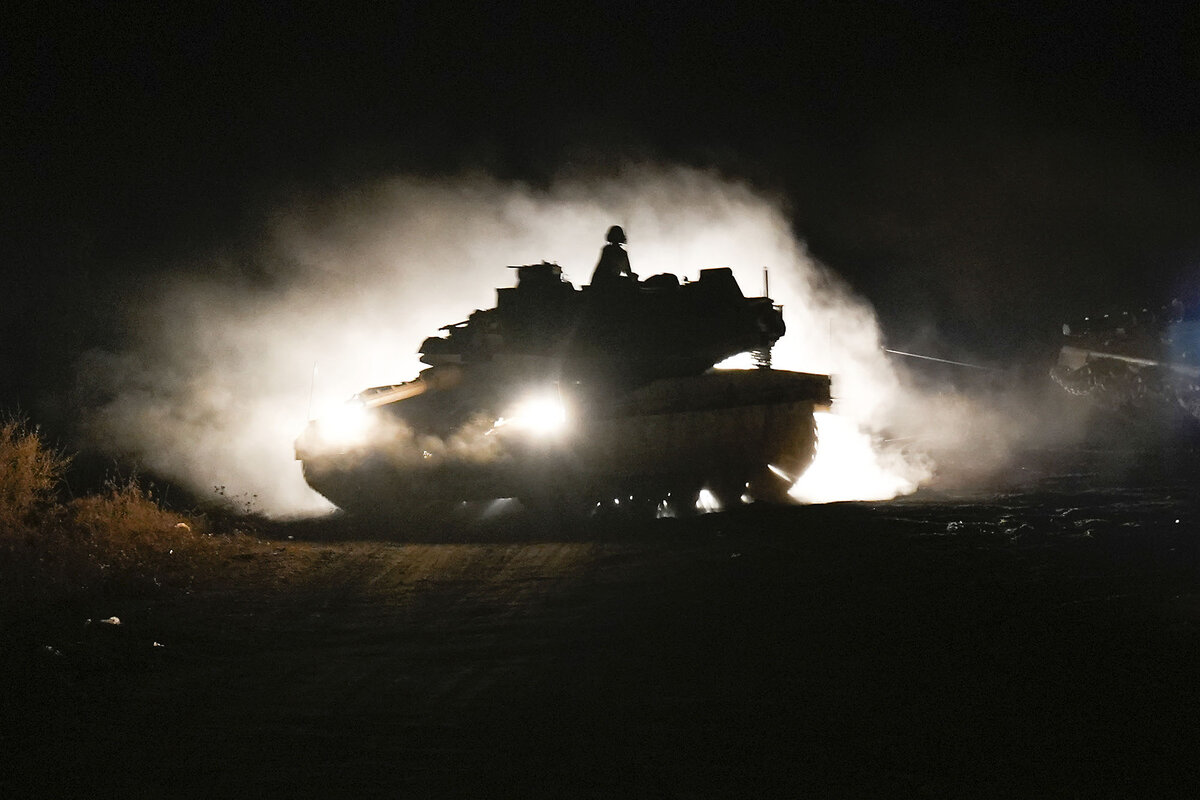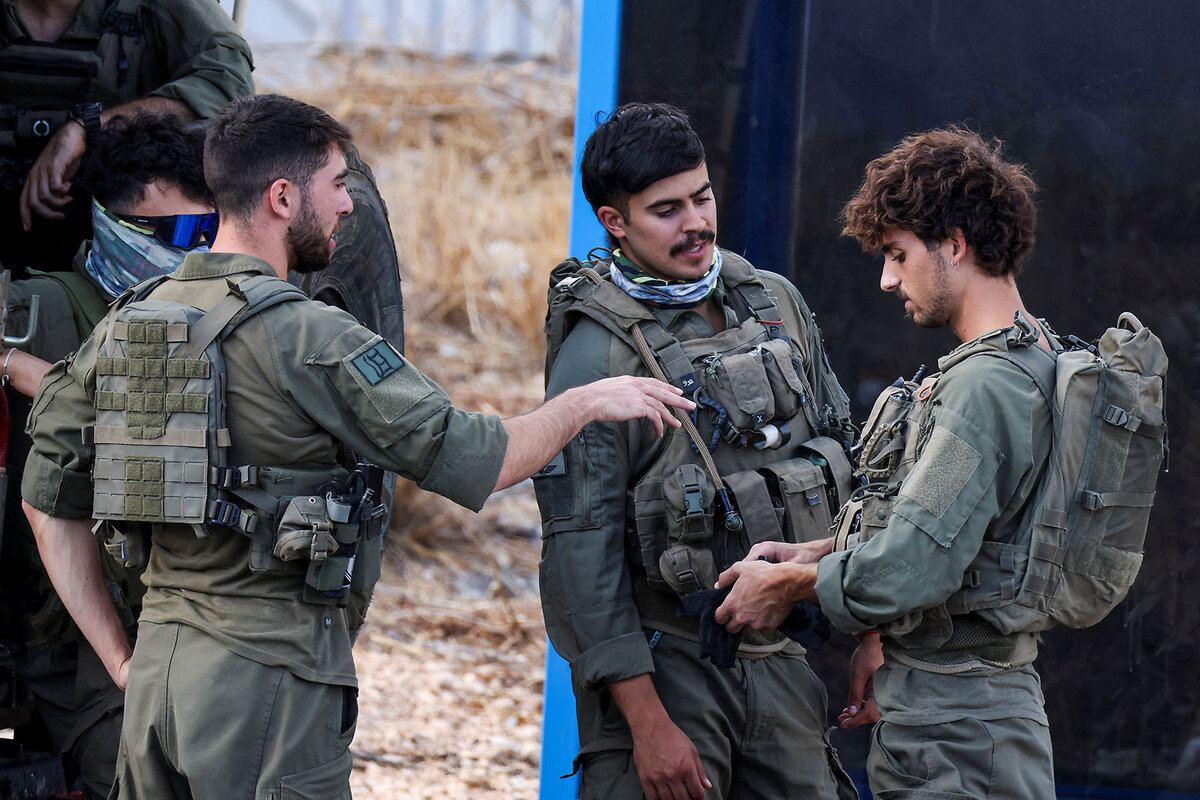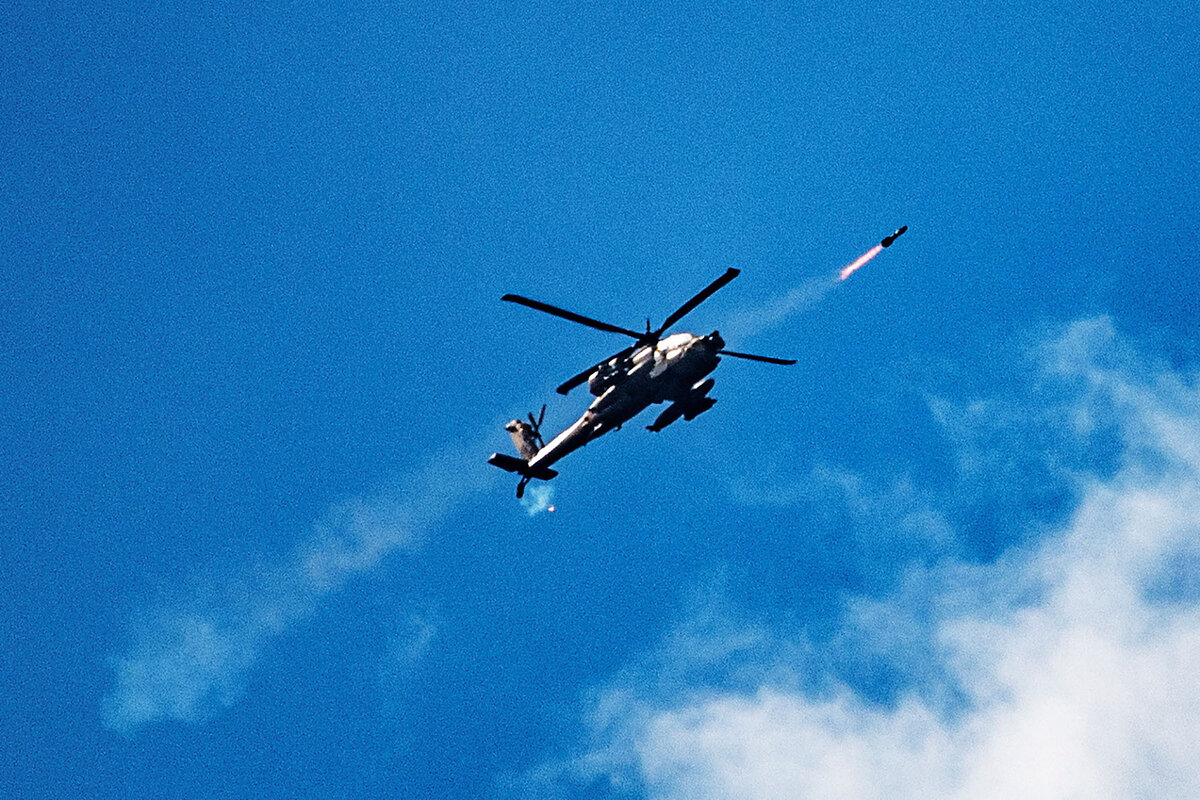Iranian missiles and Israeli invasion of Lebanon bring Mideast back to the brink
Loading...
| TEL AVIV, Israel
Iran launched a broad missile attack against Israel Tuesday evening, hours after Israeli ground forces crossed into southern Lebanon to further degrade Iran’s most prized regional ally, Hezbollah.
The exchange of fire followed two weeks of bold Israeli attacks that killed most of the Shiite militia’s senior echelon, including the revered Hassan Nasrallah, Iranian leader Ali Khamenei’s most trusted field commander.
Why We Wrote This
A story focused onIsrael says it sent troops into Lebanon to restore some security for its own residents. But Iran’s missile attack on central Israel, in defense of its ally Hezbollah, showed that regional security is far more complicated than a mere border operation.
The Iranian missile barrage – an indication that the Israeli incursion into Lebanon had much more significance than just a border action – threatened to ignite a regional conflagration that the United States has been trying to suppress since the Hamas attack last October. Iran’s attack was an indication further that the blows to Hezbollah are changing the regional dynamic and seen as threatening Tehran’s interests.
Israel’s incursion into Lebanon marked the first steps of an operation that Israel had promised would be “limited.” But there are fears in Israel and abroad that as with most previous Israeli incursions into this rugged territory, there may be no real exit plan.
“As always, it’s easier to begin a war, but always harder to end one. The front in Gaza reminds us how difficult these situations are for Israel,” Gili Cohen, Israel Radio’s political commentator, cautioned listeners just hours after the operation began.
Iran launched a broad missile attack against Israel Tuesday evening, hours after Israeli ground forces crossed into southern Lebanon to further degrade Iran’s most prized regional ally, Hezbollah.
The exchange of fire followed a dizzying two weeks of bold Israeli attacks that killed most of the Shiite militia’s senior echelon, including the revered Hassan Nasrallah, Iranian leader Ali Khamenei’s most trusted field commander.
The Iranian missile barrage – a clear indication that the Israeli incursion into Lebanon had much more significance than just a border action – threatened to ignite a regional conflagration that the United States has been trying to suppress since last October. Ever since Hamas launched a deadly attack into Israel on Oct. 7, triggering the war in Gaza, Hezbollah has been firing into Israel in support of its Palestinian ally.
Why We Wrote This
A story focused onIsrael says it sent troops into Lebanon to restore some security for its own residents. But Iran’s missile attack on central Israel, in defense of its ally Hezbollah, showed that regional security is far more complicated than a mere border operation.
Iran’s attack, which Israel said included 180 Iranian missiles and lasted just under an hour, was an indication further that the death of Mr. Nasrallah and the blows to Hezbollah are changing the regional dynamic and seen as threatening Iran’s interests.
Eyewitness reports in Jordan suggested that several Iranian missiles were intercepted over the Jordanian desert. Israeli TV showed heavy damage to a school in Gedera, in central Israel, and reported that a Palestinian worker from Gaza was killed in Jericho, in the West Bank.
In Lebanon, the incursion by Israeli paratroopers, commandos, and an armored unit marked the first steps of an operation Israel had promised would be “limited.”
Gili Cohen, Israel Radio’s political commentator, says the threat of Hezbollah carrying out an attack similar to Oct. 7, along with the promise that a ground incursion would indeed be a limited mission in scope, helped convince the Americans to green-light it.
According to the Israel Defense Forces (IDF), it is focused on destroying tunnels, hideouts, missiles, and other weaponry the Iranian proxy force has used to assault Israeli border communities for the past year.
Before the missile attack, Israel said it had received a warning from the U.S. that an Iranian attack was imminent, and the Home Front Command instructed people living in central Israel and elsewhere to “stay close to a protected space.”
“We are prepared at the highest level together with our friends the United States,” Daniel Hagari, the IDF spokesperson, said in an address to the country.
Hezbollah also fired five missiles toward central Israel Tuesday, in two salvos, before Iran struck, and Israel continued its airstrikes in Beirut.
Earlier, as news broke in Israel about the ground war, a static-filled recording of Elad Tzuri, commander of Israel’s 7th Armored Brigade, addressing his troops before they went into Lebanon was broadcast on Israeli media: “Your mission is to destroy the infrastructure of Hezbollah and kill them wherever hiding. The Israeli people are depending on us.”
But there are fears both abroad and at home that as with most previous Israeli incursions into this rugged territory, there may be no real exit plan.
“As always, it’s easier to begin a war, but always harder to end one, the front in Gaza reminds us how difficult these situations are for Israel,” Ms. Cohen cautioned listeners just hours after the operation began.
Goals of ground operation
The stated goal of sending troops into southern Lebanon is to enable Israel’s some 65,000 residents who live near the country’s northern border to return home almost a year after they were evacuated.
The day after Hamas launched its catastrophic attack on Israel’s southern border, killing some 1,200 people and taking another 250 hostage, Hezbollah began firing on northern Israel in what it said was an act of solidarity with a fellow member of the Iranian “Axis of Resistance.”
Hezbollah made a cease-fire in Gaza the condition for stopping its daily barrages.
More than 8,000 Hezbollah rockets have been shot toward border-area towns, villages, and IDF installations in the past year, destroying homes and businesses and burning large swaths of forests. Displaced residents were sent to hotels or temporary homes in the center of the country.
Following their successes against Hezbollah over the previous two weeks, Israeli officials who decided to proceed with the ground invasion did so at least in part because of comments from Hezbollah that the group would continue to fight after Mr. Nasrallah’s death.
According to Yossi Kuperwasser, a retired brigadier general and former head of the Research Division of the IDF’s Military Intelligence, they decided to seize the advantage they currently have to disable Hezbollah to make the return of the northern residents possible.
Israel has been pounding Hezbollah positions in southern Lebanon for days. That will help facilitate the operation, says General Kuperwasser, but it is not enough to get to the many tunnels and other “hidden infrastructure that may look like benign facilities but that in some cases may be hideouts.”
There are concerns that the labyrinth of tunnels Hezbollah has been building for nearly 20 years since the last Lebanon war, in 2006, could include passages inside Israeli territory.
The end phase of Israel’s limited operation remains unclear. Most analysts say it will likely include some version of a security zone south of the Litani River.
Israel patrolled a security zone in southern Lebanon in the aftermath of its 1982 invasion of the country. It withdrew in 2000 after a public backlash by those weary of the guerrilla war against their forces by Hezbollah militants, but proponents note that it did prevent deadly cross-border attacks that had been so harrowing for Israeli citizens.
Exit strategy
General Kuperwasser says he is not sure what exit strategy exists, but, “There has to be a way to guarantee that Hezbollah operatives do not come back and pose a threat to those living along the northern border again.”
There’s little trust within Israel that the Lebanese army or an international force would be sufficient protection against Hezbollah in a security zone, at least not in the near future. But there are ideas being floated that after a certain period, perhaps Israel would be able to monitor what is happening from its own side of the border with the help of technology that did not exist when Israel withdrew in 2000.
For now, the strategy that appears in place is that the dismantling of Hezbollah’s ability to strike Israel from the border area will eventually lead to a diplomatic deal that will ensure Hezbollah forces are pushed back across the Litani River. Such an agreement was made in 2006, but never implemented.
“The important thing is that we are at a stage where we are turning the tables. Until now, it was the Iranians shaping the Middle East in a way that is dangerous for Israel and its ability to defend itself, and now tables have turned,” says General Kuperwasser. “It happened gradually, but the pace accelerated dramatically, and the structure Iran built is cracking and they are now on the defensive.”











